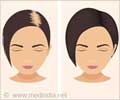Many men suffer from male pattern baldness. Some find toupees or hairpieces uncomfortable, but turning the remaining hair into a combover is rarely an attractive option either.
It starts with a receding hairline during puberty followed by a bald spot on the back of the head. Soon, only a fringe of hair remains where there had once been a full and proud thatch.
Many men suffer from male pattern baldness. Some find toupees or hairpieces uncomfortable, but turning the remaining hair into a combover is rarely an attractive option either. The best look remains a short, simple cut."By age 50, about 50 percent of men have some hair loss, but in many different ways," said Ulrike Blume-Peytavi, head of the Clinical Research Centre for Hair and Skin Physiology at Charite Hospital here.
Of course, everyone has some natural hair loss. A normal person has about 100,000 hair follicles and loses about 60 to 70 a day. "But if it turns into 60 to 100 strands a day, you should get it looked at," says dermatologist Rolf Hoffmann.
Even those levels of hair loss do not mean baldness is imminent. If it only lasts for two or three days, Blume-Peytavi says not to worry. "But if the hair loss continues for more than eight weeks, you should go to the doctor not wait until the hair has grown noticeably thinner."
Sometimes the problem is spot baldness, but that is rare and caused by illness. "In 95 percent of men's cases, the diagnosis is inherited baldness," says Hoffmann.
Men can calculate their risk of going bald by looking at the heads of their forefathers. "The maternal grandfather is the key," says the doctor.
Advertisement
His colleague Klaus-Dieter Kaiser, a one-time hairstyling world champion, recalls with horror the way men of earlier generations would try to hide bald spots.
Covering a growing bald spot with a toupee or hairpiece should be left to those who cannot psychologically deal with going bald, says Blume-Peytavi. Another option is using popular drugs like Rogaine or Propecia to keep the balding in check.
"But you can't influence the gene. As soon as you stop taking these medications, the hair will start to fall out again," says Blume-Peytavi. These treatments can be pricey, costing up to 176 euros every three months in tablet form and 55 euros for an ointment.
Often these costs are not covered by medical insurance.
Source-IANS
SRM











